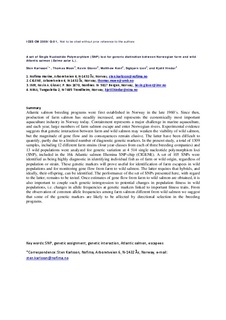| dc.description.abstract | Atlantic salmon breeding programs were first established in Norway in the late 1960´s. Since then,
production of farm salmon has steadily increased, and represents the economically most important
aquaculture industry in Norway today. Containment represents a major challenge in marine aquaculture,
and each year, large numbers of farm salmon escape and enter Norwegian rivers. Experimental evidence
suggests that genetic interaction between farm and wild salmon may weaken the viability of wild salmon,
but the magnitude of gene flow and its consequences remain elusive. The latter have been difficult to
quantify, partly due to a limited number of diagnostic genetic markers. In the present study, a total of 1309
samples, including 12 different farm strains (four year-classes from each of three breeding companies) and
13 wild populations were analyzed for genetic variation at 4 514 single nucleotide polymorphism loci
(SNP), included in the 16k Atlantic salmon Illumina SNP-chip (CIGENE). A set of 105 SNPs were
identified as being highly diagnostic in identifying individual fish as of farm or wild origin, regardless of
population or strain. These genetic markers will prove useful for identification of farm escapees in wild
populations and for monitoring gene flow from farm to wild salmon. The latter requires that hybrids, and
ideally, their offspring, can be identified. The performance of the set of SNPs presented here, with regard
to the latter, remains to be tested. Once estimates of gene flow from farm to wild salmon are obtained, it is
also important to couple such genetic introgression to potential changes in population fitness in wild
populations, i.e. changes in allele frequencies at genetic markers linked to important fitness traits. From
the observation of common allele frequencies among farm salmon different from wild salmon we suggest
that some of the genetic markers are likely to be affected by directional selection in the breeding
programs. | no_NO |
